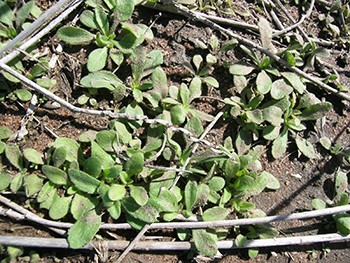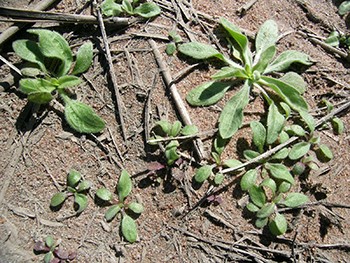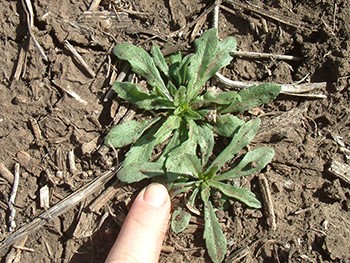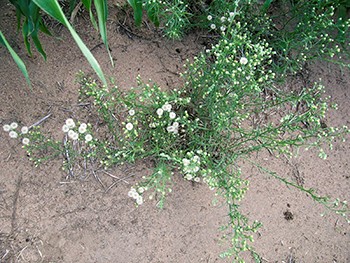Paddock Practices: Why is winter the best time to control fleabane?
Paddock Practices: Why is winter the best time to control fleabane?
Author: Toni Somes | Date: 14 Jun 2018
Controlling the weed, flaxleaf fleabane, continues to be a challenge for grain growers in Queensland and New South Wales, but research has proved targeting smaller plants during the winter fallow or winter crop phase is key to an effective management strategy.
Six tips for effective fleabane control:
- Management in winter (crop or fallow) can be more effective than summer
- Increase crop competition with narrow row spacing and or higher planting rates
- Consider strategic cultivation for seed burial or for salvage management
- Utilise residual chemistry where possible and control ‘escapes’
- Including 2,4 D or picloram/2,4-D in the first application is a critical for consistent double-knock control
- Control escapes and prevent weed seed set.

An investment by the Grains Research and Development Corporation (GRDC) into trials conducted by the Northern Grower Alliance (NGA) found fleabane management improved dramatically when grower focus shifted from controlling the weeds in summer fallow to using fleabane control tactics during winter cropping at pre-plant, in-crop and post-harvest stages or in winter fallows.
NGA’s Richard Daniel said flaxleaf fleabane (Conyza bonariensis) control had become an increasingly complex and expensive weed for northern grain growers, as a result of the industry’s heavy reliance on glyphosate and due to the wide spread implementation of no-till or reduced tillage farming systems.
“For nearly two decades, fleabane has been a major weed management issue in the northern cropping region,” Mr Daniel said.
“Factors that make fleabane a major weed includes the fact it is a prolific seed producer, with each plant producing up to 110 000 seeds; it is windborne and occurs in fallows, summer and winter crops and pastures; is difficult to control with herbicides with some populations glyphosate resistant; and the weed can emerge throughout the year.”
Mr Daniel said one of the key issues leading to fleabane being such as problem was that knock-down control of large plants in the summer fallow was expensive and delivered variable results.
“Glyphosate resistance has been confirmed in fleabane, but resistance status is variable with many samples from non-cropping areas still well controlled by glyphosate, whilst increased levels of resistance are found in fleabane in reduced tillage cropping situations.”
So what are the control and management options for growers?
Monitoring

Monitoring is a key part of weed management but it is particularly important for fleabane.
Germination of fleabane can occur all year round when wet conditions and temperatures of 10-25°C (optimal 20°C) occur. These conditions are more prevalent in autumn and spring, with fleabane often emerging with winter crops or during the winter fallow in the northern regions.
Knowing when new germinations of fleabane occur in an attempt to target control of small plants is critical as it is more effective than on larger plants. As fleabane grows its stem becomes harder and it develops a strong root system. The harder stems and large root system of larger plants enable the plants to regrow more effectively following herbicide applications.
Actively managing fleabane during winter in fallows or in-crop is more effective then summer as emerging seedlings are slower to grow. This slower growth allows more time to apply effective herbicide control options. It is also very important to manage winter germinating fleabane prior to spring as fleabane grows rapidly as the season warms and rainfall increases in northern regions leading into to summer.
While paddock control is critical so is monitoring fencelines and channels as fleabane is wind dispersed, continual replenishment of the seedbank can occur if these areas are ignored.
Crop Competition
Managing fleabane in-crop is a useful tool as fleabane does not establish well in low light conditions. Light conditions can be manipulated by planting crops at higher density and on narrower row spacing. Narrow rows and higher plant populations are primarily used when planting winter crops compared with the wider summer row spacing configurations in the northern region.

It is important to monitor crops as fleabane can survive at small growth stages under a competitive crop and be easily overlooked. However, once the crop is removed the fleabane which is present can develop quickly and the opportunity for effective control can be missed without regular monitoring.
Cultivation
Fleabane is a weed that proliferates in no-till farming systems. This is partly because many populations of fleabane present under this system now have a level of resistance to glyphosate but also due to the weed’s ecology. Due to its small seed size, fleabane will only emerge from the top 1cm of soil.
Cultivation to bury seed to a depth deeper than 1cm can be an effective tool to manage fleabane populations. Although this approach can dramatically reduce the number of fleabane which emerge, it also increases the longevity of the seed i.e. seed that is buried will not germinate but it will remain viable for a longer period. Occasional cultivation can be a useful tool for seed bank management but this is not a technique to utilise frequently as it will simply return viable seeds to the soil surface.
Cultivation may also be a viable option for salvage management. Where ‘blow outs’ occur this may be the only economic option to effectively control large flowering plants.
Herbicide strategies
Fleabane management improved dramatically when growers switched from trying to control large plants in summer fallow to targeting small weeds still in the rosette stage during the winter crop phase. There are three key stages where herbicides can be useful to manage fleabane populations; pre-plant, in-crop and post-harvest.

Residual herbicides (fallow and in-crop)
One of the most effective strategies to manage fleabane is the use of residual herbicides in fallow or in-crop. Trials have consistently shown good levels of efficacy from a range of residual herbicides commonly used in sorghum, cotton, chickpeas and winter cereals.
Residual (and knock-down) in fallow:
In Fallow, at least 3 months prior to planting sorghum: FallowBoss® Tordon® (300 g/L 2,4 D + 75 g/L picloram + 7.5 g/L aminopyralid) at 700 mL/ha + atrazine (600 g ai/L) at 3-5 L/ha
Trial work to date has indicated that increasing water volumes from 50-100 L/ha may help the consistency of residual control with application timing to ensure good herbicide/ soil contact also important.
Knock-down herbicides in fallow:
Group I herbicides have been the key products for fallow management of fleabane with 2,4 D amine and picloram/2,4-D products the most consistent herbicides evaluated. Despite glyphosate alone generally giving poor control of fleabane, trial work has consistently shown a benefit from tank mixing glyphosate with 2,4-D and picloram/2,4-D products in the first application.
- Amicide® Advance (700 g/L 2,4-D) at 0.65-1.1 L/ha + Weedmaster DST (470 g/L glyphosate) at a min of 1.4 L/ha. Follow with a double-knock of Nuquat® (250 g/L paraquat) at 1.6 -2.0 L/ha when weeds are from stem elongation to flowering.
- FallowBoss Tordon at 700 mL/ha + glyphosate (450 g/L) at 1.6-2.4L/ha (can also be followed 5-7 days later with Spray.Seed® at 1.6 L/ha as a double-knock) - prior to winter cereals or sorghum.
- Tordon® 75 D (2,4 D + picloram) at 0.7 L/ha + glyphosate
- Sharpen® (700 g/kg saflufenacil) at 17-34 g/ha + 1% Hasten® spray oil.
Post emergent herbicides in winter cereals:
- Amicide Advance at 1.5 L/ha
- FallowBoss Tordon at 300 mL/ha
- Hotshot® (10 g/L aminopyralid + 140 g/L fluroxypyr) at 750 mL/ha + either metsulfuron (600 g ai/kg) at 5 g/ha or MCPA LVE (600 g ai/L) at 580 mL/ha (refer to label for appropriate growth stages)
- Lontrel® Advanced (600 g/l clopyralid) at 150 mL/ha
- Paradigm® (200 g/kg halauxifen Group I + 200 g/kg florasulam Group B) at 25 g/ha + MCPA LVE (600 g ai/L) at 300-600 mL/ha.
Double-knock control
The use of a double-knock strategy is recommended for the control of fleabane in fallow systems as weed size increases and herbicide efficacy generally reduces. The most consistent and effective double-knock control of fleabane has involved including 2,4 D or picloram/2,4-D products + glyphosate in the first application followed by paraquat or Sharpen as the second. Glyphosate alone followed by paraquat will result in high levels of leaf desiccation but plants will generally recover. Trial work conducted by the NGA in the north has shown regrowth observed following the application of Sharpen as the second knock to be more consistent than other group G herbicides or paraquat when applied at the same timing.
Timing of the second application in fleabane is approximately 7-14 days after the first application. However, the interval to the second knock appears quite flexible. Increased efficacy is obtained when fleabane is actively growing or if rosette stages can be targeted. Although complete control can be obtained in some situations, control levels frequently only reached approximately 70-80%, particularly when targeting large flowering fleabane under moisture stressed conditions. The high cost of fallow double-knock approaches, and inconsistency in the control level of large mature plants, is a key reason that proactive fleabane management should be focussed at earlier growth stages.

More Information
Contact
Richard Daniel, NGA
Useful Resources
Flaxleaf fleabane factsheet on the GRDC website.
GRDC Update paper Farming systems strategies to manage fleabane and feathertop Rhodes grass.
Further detail about Flaxleaf Fleabane in the GRDC's Integrated Weed Management Manual.
Managing fleabane in zero-till farming systems webinar on YouTube.
